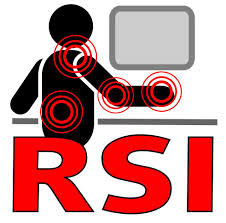Being sedentary is not the only work hazard for those of us spending hours working at our computers. Musculoskeletal diseases involving muscle, tendon, ligament, and nervous system injuries are caused by repetitive tasks—like keyboard use. Carpal tunnel syndrome (CTS) is often given as an example of this kind of musculoskeletal injury but other aches and pains occur as well.
Some of the names used to designate these injuries include repetitive strain/stress injury (RSI), musculoskeletal disorder (MSD), occupational overuse syndrome (OOS), cumulative trauma disorder (CTD), work-related musculoskeletal disorder (WRMD) and probably some others that I haven’t thought to include. None of these terms is a medical diagnosis (like carpal tunnel syndrome (CTS) or Guyon’s canal compression). These terms are just descriptive of a process involving soft tissues.
There are many variables involved in these musculoskeletal disorders such as age (risk increases as we age) and gender (women more likely than men), and activities other than working at the computer. Injury results from cumulative trauma rather than a single event like an ankle sprain when running or walking. It is not only our hours spent keyboarding or using the mouse that contribute to the injury. The time spent chopping and dicing in the kitchen or knitting can add to the cumulative trauma, so it is important that we pay attention to the symptoms.
These disorders are insidious in onset—easily ignored when they first occur. The first symptom is likely to be merely discomfort that is intermittent. We feel it at the end of the workday, but it’s gone by the next morning, so we work as usual. The discomfort may be in arms, neck, hands and/or shoulders, and will likely increase and become persistent if ignored. Even our eyes can be affected by these disorders.
Pain and discomfort are the body’s way to tell us that tissue injury is occurring. Some low-grade RSI can resolve with early treatment such as analgesics and rest. Longer-standing symptoms may require more aggressive treatment such as splinting or even surgery. The best “treatment” for this kind of injury is prevention. Some preventative measures are simple and inexpensive, but very important: attention to posture, sitting position, stretching exercises, and breaks.
________________________________________
Editor’s note: This article is part of a series on occupational challenges for freelance folks who sit in front of computers most of the day. Look for more on the details of making your workplace human-body friendly from our resident indexer and DO, S. Anne Fifer.




Leave a Reply